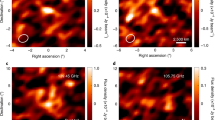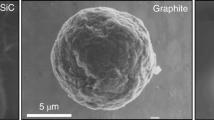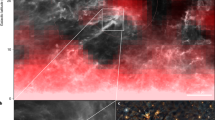Abstract
The Solar System originated in a cloud of interstellar gas and dust. The dust is in the form of amorphous silicate particles1,2 and carbonaceous dust. The composition of cometary material, however, shows that a significant fraction of the amorphous silicate dust was transformed into crystalline form during the early evolution of the protosolar nebula3. How and when this transformation happened has been a question of debate, with the main options being heating by the young Sun4,5 and shock heating6. Here we report mid-infrared features in the outburst spectrum of the young Sun-like star EX Lupi that were not present in quiescence. We attribute them to crystalline forsterite. We conclude that the crystals were produced through thermal annealing in the surface layer of the inner disk by heat from the outburst, a process that has hitherto not been considered. The observed lack of cold crystals excludes shock heating at larger radii.
This is a preview of subscription content, access via your institution
Access options
Subscribe to this journal
Receive 51 print issues and online access
$199.00 per year
only $3.90 per issue
Buy this article
- Purchase on Springer Link
- Instant access to full article PDF
Prices may be subject to local taxes which are calculated during checkout

Similar content being viewed by others
References
Kemper, F., Vriend, W. J. & Tielens, A. G. G. M. The absence of crystalline silicates in the diffuse interstellar medium. Astrophys. J. 609, 826–837 (2004)
Li, M. P., Zhao, G. & Li, A. On the crystallinity of silicate dust in the interstellar medium. Mon. Not. R. Astron. Soc. 382, L26–L29 (2007)
Hanner, M. S., Lynch, D. K. & Russell, R. W. The 8–13 micron spectra of comets and the composition of silicate grains. Astrophys. J. 425, 274–285 (1994)
Gail, H.-P. Radial mixing in protoplanetary accretion disks. I. Stationary disc models with annealing and carbon combustion. Astron. Astrophys. 378, 192–213 (2001)
Bockelée-Morvan, D., Gautier, D., Hersant, F., Huré, J.-M. & Robert, F. Turbulent radial mixing in the solar nebula as the source of crystalline silicates in comets. Astron. Astrophys. 384, 1107–1118 (2002)
Harker, D. E. & Desch, S. J. Annealing of silicate dust by nebular shocks at 10 AU. Astrophys. J. 565, L109–L112 (2002)
Herbig, G. H. Eruptive phenomena in early stellar evolution. Astrophys. J. 217, 693–715 (1977)
Hartmann, L. & Kenyon, S. J. The FU Orionis phenomenon. Annu. Rev. Astron. Astrophys. 34, 207–240 (1996)
Jones, A. F. A. L. EX Lupi. Central Bureau Electronic Telegrams 1217, (2008)
Kóspál, Á. et al. The extreme outburst of EX Lupi in 2008: optical spectra and light curve. Inf. Bull. Var. Stars 5819, 1–4 (2008)
Dorschner, J., Begemann, B., Henning, Jaeger, C. & Mutschke, H. Steps toward interstellar silicate mineralogy. II. Study of Mg-Fe-silicate glasses of variable composition. Astron. Astrophys. 300, 503–520 (1995)
Jaeger, C. et al. Steps toward interstellar silicate mineralogy. IV. The crystalline revolution. Astron. Astrophys. 339, 904–916 (1998)
Koike, C. et al. Compositional dependence of infrared absorption spectra of crystalline silicate. II. Natural and synthetic olivines. Astron. Astrophys. 399, 1101–1107 (2003)
Lisse, C. M. et al. Spitzer spectral observations of the Deep Impact ejecta. Science 313, 635–640 (2006)
Bouwman, J. et al. Processing of silicate dust grains in Herbig Ae/Be systems. Astron. Astrophys. 375, 950–962 (2001)
van Boekel, R. et al. The building blocks of planets within the ‘terrestrial’ region of protoplanetary disks. Nature 432, 479–482 (2004)
Sipos, N. et al. The optical–infrared properties of EX Lupi in quiescent phase. Astron. Astrophys. (submitted)
Hallenbeck, S. L., Nuth, J. A. & Daukantas, P. L. Mid-infrared spectral evolution of amorphous magnesium silicate smokes annealed in vacuum: comparison to cometary spectra. Icarus 131, 198–209 (1998)
Colangeli, L. et al. The role of laboratory experiments in the characterisation of silicon-based cosmic material. Astron. Astrophys. Rev. 11, 97–152 (2003)
Ciesla, F. J. Two-dimensional transport of solids in viscous protoplanetary disks. Icarus 200, 655–671 (2009)
Bringa, E. M. et al. Energetic processing of interstellar silicate grains by cosmic rays. Astrophys. J. 662, 372–378 (2007)
Glauser, A. M. et al. Formation of crystalline dust grains in protoplanetary disks: observational evidence for the destructive effect of X-rays, in Proc. 5th Spitzer Conf . “New Light on Young Stars: Spitzer’s View of Circumstellar Disks” 〈http://www.ipac.caltech.edu/spitzer2008/posters/AdrianGlauser_Spitzer2008Conference.pdf〉 (2008)
Quanz, S. P. et al. Evolution of dust and ice features around FU Orionis objects. Astrophys. J. 668, 359–383 (2007)
Herbst, W., Herbst, D. K., Grossman, E. J. & Weinstein, D. Catalogue of UBVRI photometry of T Tauri stars and analysis of the causes of their variability. Astron. J. 108, 1906–1923 (1994)
Sicilia-Aguilar, A. et al. The rapid outbursting star GM Cep: an EXor in Tr 37? Astrophys. J. 673, 382–399 (2008)
Watson, D. M. et al. Crystalline silicates and dust processing in the protoplanetary disks of the Taurus young cluster. Astrophys. J. Suppl. Ser. 180, 84–101 (2009)
Acknowledgements
We are grateful to A. F. Jones for providing us with timely visual observations of EX Lupi during the preparation of our infrared measurements. The presented work was partly supported by the Hungarian Research Fund. The research of Á.K. is supported by the Netherlands Organization for Scientific Research.
Author information
Authors and Affiliations
Corresponding author
Supplementary information
Supplementary Information
This file contains a Supplementary Discussion, Supplementary Figures 1-6 with Legends and Supplementary References. (PDF 284 kb)
PowerPoint slides
Rights and permissions
About this article
Cite this article
Ábrahám, P., Juhász, A., Dullemond, C. et al. Episodic formation of cometary material in the outburst of a young Sun-like star. Nature 459, 224–226 (2009). https://doi.org/10.1038/nature08004
Received:
Accepted:
Issue Date:
DOI: https://doi.org/10.1038/nature08004
This article is cited by
-
Ancillary science with Ariel: feasibility and scientific potential of young stellar object observations
Experimental Astronomy (2022)
-
AMBITION – comet nucleus cryogenic sample return
Experimental Astronomy (2022)
-
Cometary Isotopic Measurements
Space Science Reviews (2015)
-
Comet-like mineralogy of olivine crystals in an extrasolar proto-Kuiper belt
Nature (2012)
-
Cosmic crystals caught in the act
Nature (2009)
Comments
By submitting a comment you agree to abide by our Terms and Community Guidelines. If you find something abusive or that does not comply with our terms or guidelines please flag it as inappropriate.



